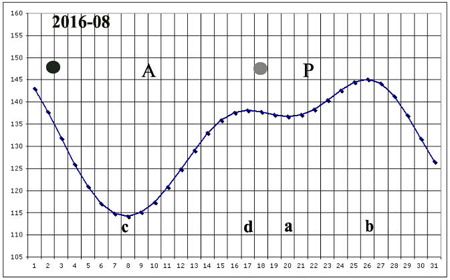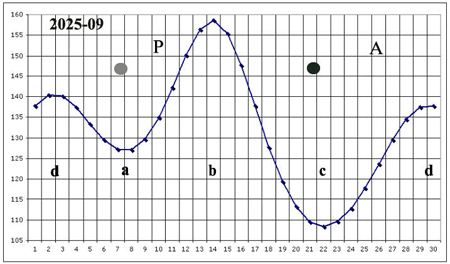prologue > index seeds > 1.1 Managing the germinative power in seeds.
1.1.1 - Introduction to cumulative dissipative cycle in seeds.
>1.1.2 - To be kept in mind in experiments.
1.1.3 - The sowing procedure.
1.1.4 - Loss and recovery of viability.
1.1.5 - Harvest result in a year of lean times.
1.1.6 - Harvest result in a year of abundance.
1.1.7 - How to get more income in times of scarsity.
1.1.8 - Applications.
============================================================
At critical angular velocity values.
As mentioned on the previous page, the processes of the cumulative-dissipative cycle occur only at critical angular velocities, with respect to other matter, during short interaction episodes.
These interaction episodes take place only on condition that there are also heat exchanges, consistent with the trend of the movement, in a cumulative sense, if the movement is increasing, in a dissipative sense, if the movement is decreasing.
We can deduce that the processes of the cumulative-dissipative cycle occur only at critical angular velocities from the different efficiency of said cycle, in three observation modalities performed in seeds (experiment A; experiment E; 18.6-year cycle ).
1 - Experiment A.
In experiment A (see more on page 1.2.3), a single sunflower seed, without its shell, is set in motion, relative to the surrounding matter many times, at random angular velocities.
The results can be the most varied. They depend on whether a critical angular velocity has been reached, for how long, and depending on how much heat dissipation has taken place.
The seeds may not undergo any variation, or may change color and tenderness to varying degrees. In rare cases, they can turn into oil, leaving a mucilage residue.
The experiment A could be performed with a machine that rotates the seed on its own axis at critical angular velocities, to be determined using said machine.
2 - Experiment E.
We can see another consequence with the results of experiment E.
The best results (harvests) of this experiment are obtained when the seeds are sown a day or a few hours before the start of a dissipative phase.
It is when the variation of the angular velocity of the seed with respect to the Moon is reduced, and the episodes of interaction - during which processes can take place, at one of the critical angular velocities - are of relatively long duration.
It is then that the processes can be more numerous, and the cycle more efficient.
3a – The efficiency of the cycle varies over the course of 18.6 years.
Another fact that attests that these processes take place during short interaction episodes at critical angular speeds is the different efficiency of the cycle, over the course of 18.6 years.
This happens because of how much the Moon's declination varies relative to the equator. The less it varies, the better.
3b – Effect of the declination of the Moon relative to the equator.
Within each sidereal month (27 days, 7 hours, 43 minutes, 12 seconds), the declination of the Moon relative to the equator has an excursion, that can range from +/-14 degrees to +/-28.5 degrees, over 18.6 years.
The more this excursion varies, the more the angular velocity of the Moon with respect to the Earth also varies, and the shorter will be the interaction episodes, during which cumulative-dissipative processes can take place. Which, I remind you, can only take place at critical angular velocities.
The shorter the interaction episodes, the more reduced the efficiency of the cumulative-dissipative processes, all other conditions not considered here being equal.
3c – As the Moon declination varies.
Let's consider two cases with different excursion of the Moon declination with regard to the equator. The percentage increase in yields that the experiment procedure allows, compared to the control, is greater in the year of shortage.
In other words, the sowing procedure recommended here provides the best results, compared to the control, precisely in years of scarcity. As can be compared later on pages 5 and 6 of this itinerary.
3d -Years of plenty.
In years in which the variation of the Moon declination with regard to the equator is less than 21 degrees, the efficiency of the cycle is in absolute high. However, the increase in yields that the procedure of the experiment allows, compared to the control outcomes, is reduced, but it is still in the order of at least +30% (see example at page 1.1.6).
The seeds sown in August 2016 (Moon declination excursion 18 degrees; reduced variation of its angular velocity around the Earth) had, on average, a high degree of viability. Generally, they have given rise to abundant crops, sold at low prices.
The angular velocity, given as hourly averahe per each day, of the delay recovering of the Moon, on its revolution around the Earth, defined in 86400 deltins, and performed during one sidereal month.

Notice the difference in excursion in the two graphs.

3e - Years of lean times.
During the seven years in which the variation of the Moon declination with regard to the equator exceeds 26 degrees (seven years of lean times), the efficiency of the cycle is low. However, the increase in yields that the procedure of the experiment allows, compared to the control outcomes, is in the order of at least +50% (see example at page 1.1.5).
The seeds that will be sown in September 2025 will have on average a low degree of germinability (excursion of the declination of the Moon 28.5 degrees, with sustained variation of its angular velocity around the Earth). As a result, the seeds will generally give poor yields, but will be sold at high prices.
Importance of the cumulative phase.
As a consequence of what is said in this itinerary, the efficiency of the cycle depends on the extent to which the cumulative phase before sowing is performed, which may become, if partially executed, the Achilles heel of the cycle, due to low viability of seeds, as the history of food crises and famines proves.
This take place when, at the same time, temperatures are reduced and the interaction episodes are short.
The dissipative phase's efficiency is consequent to what happened before, during the previous cumulative phase.
In practice, before sowing, in order to improve the cycle's efficiency, it is enough to increase the temperature during the cumulative phase, of course, well below the physiological limits valid for the seeds.